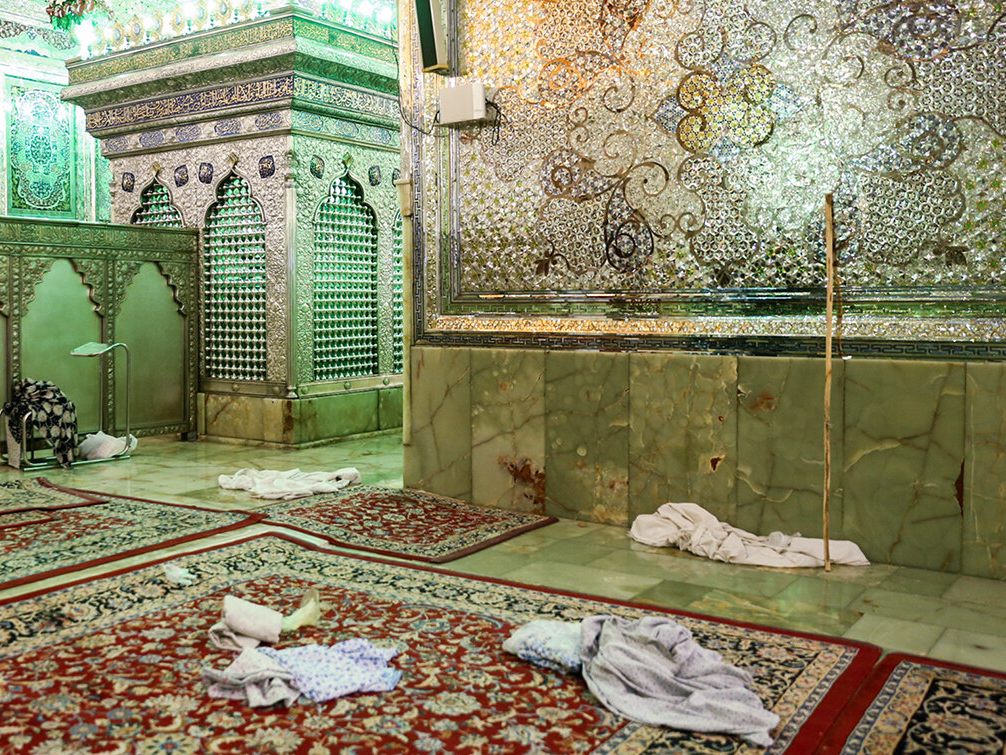The Shahgarh shrine, encompassing the shrine of Imam Ahmed, the brother of the eighth Shiite imam, Ali Al-Rida, has been targeted by IS for the second time within ten months. On August 13, the shrine was subjected to an attack resulting in the unfortunate demise of one individual, injuries sustained by eight others, and the subsequent apprehension of the perpetrator, Rakhmatullah Noroozov, a Tajik national, along with eight other foreign suspects. Regrettably, one terrorist managed to evade capture. This incident marks the second assault of its nature after the operation carried out on October 26, which led to the loss of 13 lives and left 30 others wounded.
The occurrence of this event at this particular juncture holds significant implications about the ongoing confrontation between the Iranian authorities and the aforementioned organization. Furthermore, it is intertwined with the political developments unfolding within the Iranian domestic sphere and the interactions transpiring between Iran and its Western neighboring countries.
The Motives Behind the Attack
IS’s decision to perpetrate this attack once more can be elucidated in view of various motives, with the most salient among them being:
1- IS’s choice to target the Shahgarh shrine in Iran may be attributed to its perceived vulnerability in terms of security measures compared to other Shiite shrines in the country, such as the shrine of Imam Reza in Mashhad or the shrine of Our Lady Al-Masoumeh in Qom. It is evident that the Iranian authorities have implemented rigorous security protocols in these locations, particularly following the previous attack on the shrine of Ruhollah Khomeini, the founder of the Islamic Republic, on June 7, 2017.
The evident ease with which the assailants breached the entrance of the shrine, particularly during the initial assault on October 26, indicates a notable security lapse. Despite encountering challenges in executing the second attack, the perpetrators proceeded to unleash a hail of gunfire resulting in the fatality of an individual and the injury of seven others. This unfortunate incident highlights the security lapses within the shrine.
2- The retaliatory act occurred approximately one month subsequent to the execution of certain individuals found guilty in the initial assault. On July 7th, the Iranian government proceeded with the execution of two death sentences, namely Muhammad Ramiz Rashidi and Sayyed Naimi Rashidi Qatali, on the grounds of spreading corruption on earth and working to undermine the country’s national security. Three additional individuals received prison sentences ranging from 5, 15 to 25 years.
This incident suggests that IS aims to convey a direct message to the Iranian authorities, asserting its capability to carry out further attacks within Iran.
3- Anticipating the approaching one-year mark of the Iranian protests, the second incident took place approximately a month prior to the anniversary. These protests, which occurred in mid-September, were a response to the actions taken against Mahsa Amini, a Kurdish girl who faced charges for not conforming to the hijab regulations. Tragically, this ultimately resulted in her death. The initial incident transpired amidst the intensification of these protests, providing an opportunity for the Iranian authorities to exploit the situation. They sought to propagate a narrative linking IS to certain domestic protesters, as both parties shared a common objective of sowing chaos and destabilizing the foundations of the ruling regime.
In view of this, it appears that IS is additionally endeavoring to convey a message that it possesses the ability to breach the security protocols implemented by the Iranian authorities at any given moment. This is evident even after the authorities’ effective containment of the protests. Such a demonstration reflects the organizational prowess that facilitated the recruitment of sympathizers from diverse national backgrounds to execute the aforementioned assault. Executing such a form of attack.
4- Exploiting tensions between Iran and the Taliban: It is plausible to consider the existence of a relationship, albeit indirect, between the occurrence of the second attack at the shrine and the escalating tension in the Afghan Taliban movement’s relations with Iran. This tension arises from a dispute over the allocation of river water from Helmand, which flows into Iran. Notably, the attack took place shortly after reports surfaced, revealing the Taliban’s deployment of suicide bombers and military equipment to the Iran border.
In this context, two possibilities can be achieved.
Firstly, it is conceivable that the Taliban may have disregarded IS’s attempts to infiltrate the Iranian border, despite their apparent disagreement with the organization. This disregard could be viewed as an attempt to manage the conflict with Iran.
Secondly, the organization opportunistically exploited the existing strained relations between the two parties to execute the attack, thereby exacerbating this tension and increasing the likelihood of it escalating into a direct conflict between the two parties. Consequently, the organization stands to gain the most from this situation, as it could potentially bolster its influence within both Afghanistan and Iran simultaneously.
5- The trend of capitalizing on sectarian conflict: It appears that IS will prioritize exploiting the sectarian conflict between Shiite Iran and neighboring Sunni nations in Central Asian and the Caucasus, such as Afghanistan and Tajikistan, as well as within the Iran itself. The objective is to enhance IS’s capacity to recruit additional members and incorporate them into its ranks.
The first issue pertains to the arbitrary and discriminatory policies implemented by the Iranian authorities. These policies exhibit bias and prejudice, targeting various groups such as Sunni sectarianism, ethnic nationalities, and particularly Afghan refugees.
The second issue is Iran’s significant involvement in the Syrian conflict shows how much support is needed for the Syrian regime’s sustained governance. This support was primarily facilitated through the establishment of Shiite militias, which included individuals who had sought refuge or immigrated to Iran. Notably, the Iranian authorities announced in November their successful apprehension of all “Takfiris” involved in the initial attack on the shrine. It is worth mentioning that these individuals were predominantly of foreign nationalities, particularly hailing from Afghanistan, Azerbaijan, and Tajikistan.
Exploiting Sectarian Incidents
Iran is anticipated to capitalize on the recent attack, which has been claimed by IS, in order to accomplish two objectives. The initial objective is to proactively initiate a campaign against the anticipated escalation of protests in the upcoming phase, coinciding with the approaching first anniversary of Mahsa Amini’s demise on September 15. This will be achieved by explicitly asserting that Iran’s intention is not to exert pressure for alterations in the regime’s policy across diverse political, social, and economic domains, but rather to propagate disorder, instability, and subvert the fundamental pillars of the governing regime.
The second objective is to provide further justifications for the continuation of the interventionist activities conducted by the Revolutionary Guard in neighboring countries, particularly in crisis-ridden nations. The regime seeks to justify these interventions by claiming that they are not solely aimed at “supporting the oppressed” and “combating arrogance,” but also at “combating terrorism.” However, this claim contradicts the factual evidence that indicates Iran’s consistent efforts to establish communication channels with organizations like IS and Al-Qaeda Recent operations by IS have further confirmed the existence of these channels.


